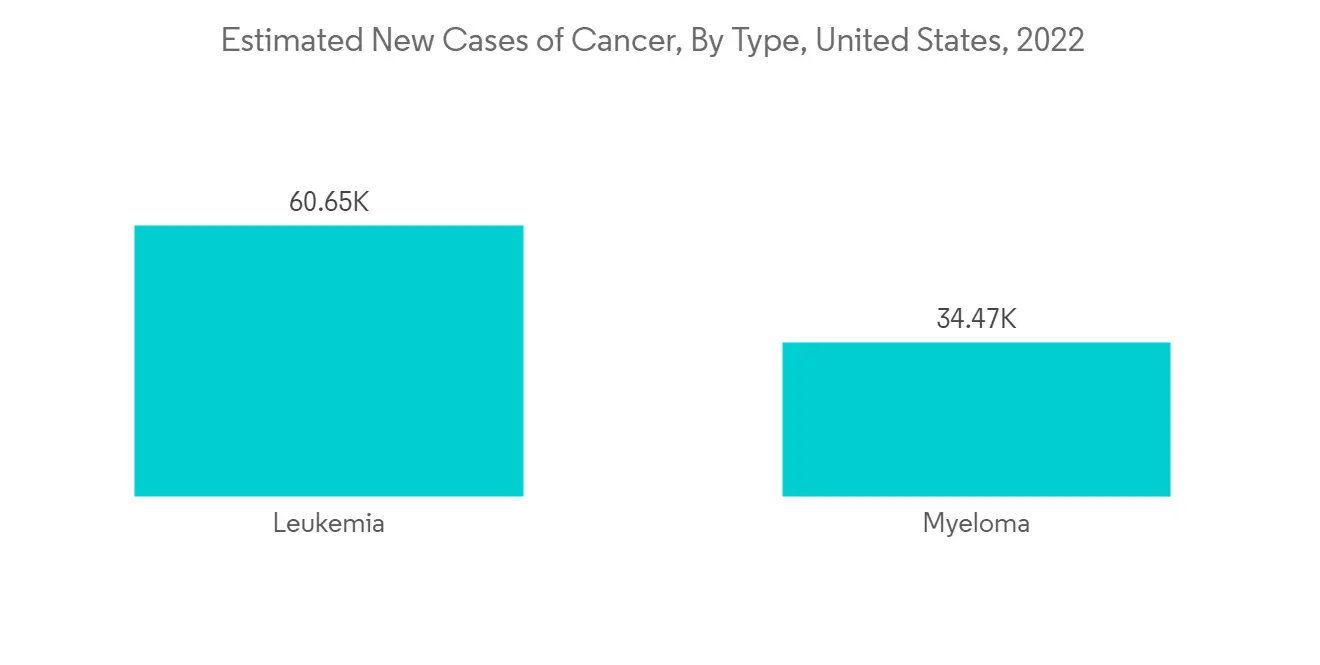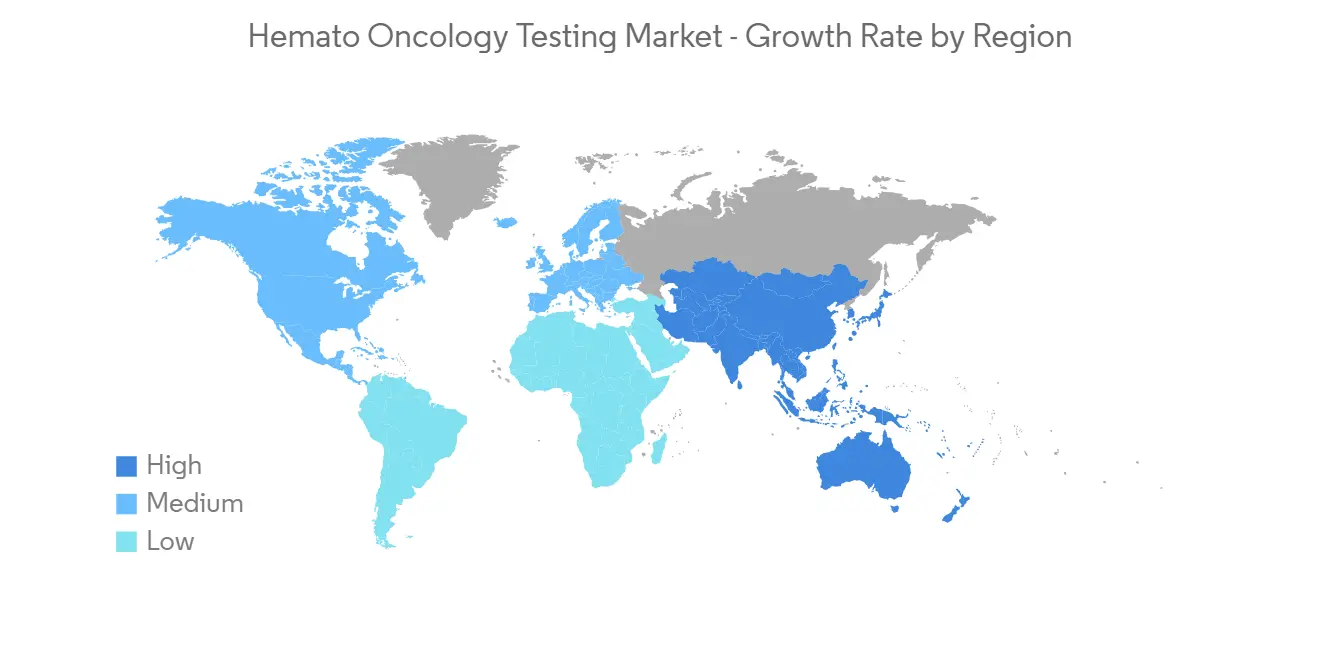 |
市场调查报告书
商品编码
1273522
血液肿瘤学检测市场 - COVID-19 的增长、趋势、影响和预测 (2023-2028)Hemato Oncology Testing Market - Growth, Trends, and Forecasts (2023 - 2028) |
||||||
※ 本网页内容可能与最新版本有所差异。详细情况请与我们联繫。
在预测期内,血液肿瘤检测市场预计将以近 5% 的复合年增长率增长。
COVID-19 疫情对确保世界各地用于癌症治疗的医院资源产生了重大影响。 例如,根据<血液肿瘤学>(Hematological Oncology) 2022 年 10 月发表的一篇文章,COVID-19 大流行给患者和医护人员带来了沉重负担,包括淋巴瘤护理,这可能会恶化患者的预后。它彻底改变了全球肿瘤学的实践。 此外,根据 2022 年 9 月发表在<临床肿瘤学杂誌>上的一篇论文,在美国进行的一项研究发现,在最初的大流行期间,新诊断的多发性骨髓瘤患者减少了 22%。 然而,在大流行的后期阶段,对包括血癌在内的癌症诊断的需求有所增加。 因此,儘管在大流行初期面临重大挑战,但随着 SARS-CoV-2 病例开始下降,癌症治疗恢復正常,并且随着时间的推移,市场经历了显着增长。
市场增长的驱动因素是血液系统癌症的发病率不断上升以及对个性化治疗的需求不断增加。 根据 PubMed Central 于 2022 年 4 月更新的一篇论文,白血病是 5 岁以下儿童中最常见的癌症之一,导致高比例的死亡并给个人、家庭和国家带来沉重负担。 儿童白血病的爆发导致对血液肿瘤学检测的需求增加,从而推动了对相关产品和服务的需求。
此外,对个性化医疗不断增长的需求也对市场增长做出了重大贡献。 个性化医疗旨在根据患者疾病的分子基础为个体患者提供量身定制的治疗,近年来变得流行起来。 各种类型癌症的患病率上升,针对癌症药物和其他各种疾病适应症的个性化药物治疗的可负担性,个性化药物的副作用较少,新兴市场的价格较高渗透率是创造个性化药物需求的一个因素。 此外,多家公司正在进行研究,以证明个性化医疗在血液相关癌症中的有效性。 例如,2021 年 9 月,加州大学癌症中心的研究人员参加了一项全国协作的个性化医学临床试验,以开发血液癌和骨癌的个性化治疗方法。
此外,产品发布也在推动市场的增长。 例如,2022 年 5 月,Genes2Me 在印度推出了基于下一代测序 (NGS) 的肿瘤学、个性化医疗和遗传病临床组合。 此外,2021 年 10 月,Sysmex Inostics 开发了一种新的液体活检测试,用于检测急性髓性白血病(AML)中的微小残留病(MRD)。 这项名为"AML-MRD-SEQ"的新测试使用靶向下一代测序 (NGS) 面板,涵盖 20 个基因和 68 个区域,包括已建立的 MRD 标记,如 NPM1。
但是,不利的赎回情景可能会减缓所研究市场的增长。
血液肿瘤学市场趋势
预计服务业在预测期内将经历显着增长
在预测期内,预计血液肿瘤检测市场的服务领域将出现显着增长。 这是由于人们对个性化医疗等先进疗法的认识不断提高,以及白血病、非霍奇金淋巴瘤和骨髓瘤等癌症的患病率不断上升。
与传统医学不同,精准医学基于每个患者独特的基因构成,并为血液系统恶性肿瘤提供更好的治疗选择。 例如,2022年7月,国家癌症中心对国家癌症中心与大冢製药株式会社联合开发的血液系统癌症(血液系统恶性肿瘤)基因组检测进行了前瞻性队列研究,结果显示非常有用。 因此,预计这种血液肿瘤检测方法将促进血液恶性肿瘤的检测服务。
此外,白血病、非霍奇金淋巴瘤和骨髓瘤在世界范围内的高患病率正在推动研究领域的增长。 例如,根据澳大利亚癌症协会2022年8月公布的数据,2022年澳大利亚估计有5202例新诊断的白血病病例。 因此,全球淋巴瘤、白血病和骨髓瘤癌症的高发增加了对血液肿瘤检测服务的需求,从而推动了研究市场的增长。
同样,根据 2021 年 ICMR-国家疾病信息学和研究中心的一份报告,白血病占印度 0-14 岁男性和女性所有儿童癌症的近一半。2021 年男孩的患病率为 46.4%女孩为 44.3%。 2021 年,男孩中另一种常见的儿童癌症是淋巴瘤 (16.4%)。 因此,预计血液癌症的高患病率将推动被调查市场的增长。

预计在预测期内北美将显着增长
北美处于该地区增长的前沿,也是全球舞台上重要的收入来源。 该细分市场的很大份额主要归因于血癌的高发率、人口老龄化、对先进治疗的认识以及该地区行业参与者的强大影响力。
白血病、淋巴瘤和多发性骨髓瘤患病率上升正在推动该地区的市场增长。 例如,根据加拿大癌症协会2022年的统计数据,2021年约有6700名加拿大人被诊断出患有白血病,其中男性4000人,女性2700人。 此外,根据美国癌症协会2023年的数据,预计2023年美国将诊断出约59,610例新发白血病病例和20,380例急性髓性白血病(AML)病例。 因此,血液肿瘤患者的高发病率导致血液肿瘤检测的增加,推动了该地区的市场。
此外,各种组织正在采取措施改善血癌治疗,这有望推动市场增长。 例如,2021 年,白血病和淋巴瘤协会 (LLS) 宣布已提供超过 2.41 亿美元的赠款,帮助美国 42,000 多名血癌患者。 因此,这些努力也支持了市场的增长。

血液肿瘤行业概览
血液肿瘤学市场分散且竞争激烈。 公司采用各种战略,包括收购、合作、研究活动投资和新产品发布,以在全球市场上从竞争对手中脱颖而出。 该市场由几家大型企业组成,其中几家大型企业目前主导着市场,包括 F. Hoffmann-La Roche Ltd、Abbott、QIAGEN、Thermo Fisher Scientific Inc. 和 Illumina Inc.。
其他福利:
- Excel 格式的市场预测 (ME) 表
- 3 个月的分析师支持
内容
第一章介绍
- 调查假设和市场定义
- 本次调查的范围
第二章研究方法论
第 3 章执行摘要
第四章市场动态
- 市场概览
- 市场驱动力
- 血癌发病率增加
- 对个性化治疗的需求不断增长
- 市场製约因素
- 不利的保险报销情况
- 波特五力
- 新进入者的威胁
- 买方/消费者议价能力
- 供应商的议价能力
- 替代品的威胁
- 竞争公司之间的敌对关係
第 5 章市场细分
- 按产品/服务
- 检测试剂盒和试剂
- 服务
- 按癌症类型
- 白血病
- 淋巴瘤
- 多发性骨髓瘤
- 其他
- 按技术
- 聚合□炼式反应 (PCR)
- 免疫组织化学 (IHC)
- 下一代测序 (NGS)
- 其他技术
- 最终用户
- 医院
- 学术和研究机构
- 其他最终用户
- 按地区
- 北美
- 美国
- 加拿大
- 墨西哥
- 欧洲
- 德国
- 英国
- 法国
- 意大利
- 西班牙
- 其他欧洲
- 亚太地区
- 中国
- 日本
- 印度
- 澳大利亚
- 韩国
- 其他亚太地区
- 中东和非洲
- 海湾合作委员会
- 南非
- 其他中东和非洲地区
- 南美洲
- 巴西
- 阿根廷
- 其他南美洲
- 北美
第6章竞争格局
- 公司简介
- F. Hoffmann-La Roche Ltd
- Abbott
- Invitae Corporation(Archerdx, Inc)
- QIAGEN
- Thermo Fisher Scientific Inc.
- Illumina Inc.
- Bio-Rad Laboratories, Inc.-
- Molecularmd(Subsidiary of Icon PLC)
- Asuragen, Inc.
- Arup Laboratories Inc.
- Icon PLC
- Adaptive Biotechnologies.
- Invivoscribe, Inc.
第7章 市场机会与将来动向
The Hemato Oncology Testing Market is expected to register a CAGR of nearly 5% during the forecast period.
The COVID-19 outbreak significantly impacted the availability of hospital resources for cancer care worldwide. For instance, according to an article published by Hematological Oncology in October 2022, the COVID-19 pandemic introduced significant changes in oncologic practice globally, including lymphoma care with a substantial burden on patients and healthcare providers and the potential worsening of patient outcomes. Moreover, according to an article published by the Journal of Clinical Oncology in September 2022, a study was conducted in the United States, which showed that the number of newly diagnosed multiple myeloma patients decreased by 22% during the initial pandemic. However, in the later phase of the pandemic, there was an increase in the demand for cancer diagnostics, including hematological cancers. Thus, the market witnessed significant challenges during the initial phase of the pandemic, but as the SARS-CoV-2 cases started to decline, cancer care went back to normal, and the market witnessed significant growth over time.
The factors that are driving the market growth are the increasing incidence of hematologic cancer and the growing demand for personalized therapy. According to an article updated by PubMed Central in April 2022, leukemia is considered one of the most common cancers in children younger than five years of age, and it accounts for a high percentage of deaths, creating a significant burden on individuals, families, and countries. The occurrence of leukemia in children is leading to the increase in demand for hemato oncology testing, thereby driving the demand for products and services associated with it.
Besides, the growing demand for personalized therapy is also significantly contributing to the market growth. Personalized medicine aims to provide tailor-made therapies to individual patients depending on the molecular basis of the disease, and it has become popular over recent years. The rise in the prevalence of various types of cancer, affordability of personalized medicine therapy in cancer drugs and various other disease indications, fewer side-effects of personalized medicine, and high adoption in developed markets are factors that are creating demand for personalized therapy. Moreover, various firms are conduction studies to prove the effectiveness of personalized medicine in blood-related cancer. For instance, in September 2021, the UC Cancer Center researchers joined a national collaborative, personalized medicine clinical trial for developing personalized treatments for blood and bone cancer.
Additionally, the launch of products is also propelling the market's growth. For instance, in May 2022, Genes2Me launched next-generation sequencing (NGS) based clinical panels for oncology, personalized medicine, and hereditary diseases in India. Furthermore, in October 2021, Sysmex Inostics developed a new liquid biopsy test for the detection of minimal residual disease (MRD) in acute myeloid leukemia (AML). The new test, AML-MRD-SEQ, uses a targeted next-generation sequencing (NGS) panel that covers 68 regions across 20 genes, including established MRD markers such as NPM1.
However, unfavorable reimbursement scenarios may slow down the growth of the studied market.
Hemato Oncology Testing Market Trends
Services Segment is Expected to Witness Significant Growth over the Forecast Period
The services segment is expected to witness significant growth in the hemato-oncology testing market over the forecast period. This can be attributed to increasing awareness of advanced therapies such as personalized medicine and the rising prevalence of leukemia, non-Hodgkin lymphoma, and myeloma cancers.
Precision medicine is based on each patient's unique genetic makeup as opposed to traditional medicine, and it provides better treatment for hemato oncology treatment. For instance, in July 2022, The National Cancer Center conducted a prospective cohort study on the gene panel testing for blood cancers (hematological malignancies) developed with Otsuka Pharmaceutical Co., and it showed that the clinical utility of the panel testing was notably high in diagnosis and prognosis. Thus, such initiatives in hemato-oncology testing are expected to boost the testing services for hemato-oncological diseases.
Also, the high global prevalence of leukemia, non-Hodgkin's lymphoma, and myeloma cancer is driving the growth of the studied segment. For instance, according to the data published by Cancer Australia in August 2022, an estimated 5,202 new cases of leukemia were diagnosed in Australia in 2022. Thus, the high incidence of lymphoma, leukemia and myeloma cancer globally is increasing the demand for hemato oncology testing services, thereby propelling the growth of the studied market.
Similarly, according to a report published by ICMR-National Centre for Disease Informatics and Research in 2021, leukemia accounted for nearly half of all childhood cancers in both genders in the 0-14 years age group in India; it had a prevalence of 46.4% in boys and 44.3% in girls in 2021. The other common childhood cancer in boys was found to be lymphoma (16.4%) in 2021. Hence, the high prevalence of hematologic cancers is expected to drive the growth of the studied market.

North America Region is Expected to Witness Significant Growth over the Forecast Period
North America is at the forefront of growth in the region and is also an important revenue contributor in the global arena. The large share of this segment can primarily be attributed to the high incidences of hematologic cancer, the aging population, awareness regarding advanced treatment methods, and the strong presence of industry players in the region.
The rising prevalence of leukemia, lymphoma, and multiple myeloma is stimulating the growth of the market in the region. For instance, as per the Canada Cancer Society's statistics for 2022, around 6,700 Canadians were diagnosed with leukemia in 2021, out of which 4,000 were men and 2,700 were women. Also, as per the American Cancer Society's data for 2023, around 59,610 new cases of leukemia and 20,380 new cases of acute myeloid leukemia (AML) are expected to be diagnosed in the United States in 2023. Thus, the high incidence of blood cancer cases is leading to an increase in hemato oncology testing, thereby driving the market in the region.
Furthermore, various organizations are taking initiatives for better blood cancer care which is expected to drive market growth. For instance, in 2021, the Leukemia & Lymphoma Society (LLS) announced that they provided more than USD 241 million in grants to support over 42,000 blood cancer patients in the United States. Hence, such initiatives are also supporting market growth.

Hemato Oncology Testing Industry Overview
The hemato-oncology testing market is fragmented and competitive in nature. The companies have been following various strategies such as acquisitions, partnerships, investments in research activities, and new product launches to sustain themselves among the competitors in the global market. The market consists of several major players, and a few of the major players are currently dominating the market, which include F. Hoffmann-La Roche Ltd, Abbott, QIAGEN, Thermo Fisher Scientific Inc., and Illumina Inc.
Additional Benefits:
- The market estimate (ME) sheet in Excel format
- 3 months of analyst support
TABLE OF CONTENTS
1 INTRODUCTION
- 1.1 Study Assumptions and Market Definition
- 1.2 Scope of the Study
2 RESEARCH METHODOLOGY
3 EXECUTIVE SUMMARY
4 MARKET DYNAMICS
- 4.1 Market Overview
- 4.2 Market Drivers
- 4.2.1 Increasing Incidence of Hematologic Cancer
- 4.2.2 Growing Demand for Personalized Therapy
- 4.3 Market Restraints
- 4.3.1 Unfavorable Reimbursement Scenario
- 4.4 Porter Five Forces
- 4.4.1 Threat of New Entrants
- 4.4.2 Bargaining Power of Buyers/Consumers
- 4.4.3 Bargaining Power of Suppliers
- 4.4.4 Threat of Substitute Products
- 4.4.5 Intensity of Competitive Rivalry
5 MARKET SEGMENTATION (Market Size by Value - USD million)
- 5.1 By Product & Services
- 5.1.1 Assay Kits and Reagents
- 5.1.2 Services
- 5.2 By Cancer Type
- 5.2.1 Leukemia
- 5.2.2 Lymphoma
- 5.2.3 Multiple Myeloma
- 5.2.4 Others
- 5.3 By Technology
- 5.3.1 Polymerase chain reaction (PCR)
- 5.3.2 Immunohistochemistry (IHC)
- 5.3.3 Next-Generation Sequencing (NGS)
- 5.3.4 Other Technology
- 5.4 By End User
- 5.4.1 Hospitals
- 5.4.2 Academic & Research Institutes
- 5.4.3 Other End-Users
- 5.5 Geography
- 5.5.1 North America
- 5.5.1.1 United States
- 5.5.1.2 Canada
- 5.5.1.3 Mexico
- 5.5.2 Europe
- 5.5.2.1 Germany
- 5.5.2.2 United Kingdom
- 5.5.2.3 France
- 5.5.2.4 Italy
- 5.5.2.5 Spain
- 5.5.2.6 Rest of Europe
- 5.5.3 Asia-Pacific
- 5.5.3.1 China
- 5.5.3.2 Japan
- 5.5.3.3 India
- 5.5.3.4 Australia
- 5.5.3.5 South Korea
- 5.5.3.6 Rest of Asia-Pacific
- 5.5.4 Middle East and Africa
- 5.5.4.1 GCC
- 5.5.4.2 South Africa
- 5.5.4.3 Rest of Middle East and Africa
- 5.5.5 South America
- 5.5.5.1 Brazil
- 5.5.5.2 Argentina
- 5.5.5.3 Rest of South America
- 5.5.1 North America
6 COMPETITIVE LANDSCAPE
- 6.1 Company Profiles
- 6.1.1 F. Hoffmann-La Roche Ltd
- 6.1.2 Abbott
- 6.1.3 Invitae Corporation (Archerdx, Inc)
- 6.1.4 QIAGEN
- 6.1.5 Thermo Fisher Scientific Inc.
- 6.1.6 Illumina Inc.
- 6.1.7 Bio-Rad Laboratories, Inc.-
- 6.1.8 Molecularmd (Subsidiary of Icon PLC)
- 6.1.9 Asuragen, Inc.
- 6.1.10 Arup Laboratories Inc.
- 6.1.11 Icon PLC
- 6.1.12 Adaptive Biotechnologies.
- 6.1.13 Invivoscribe, Inc.













